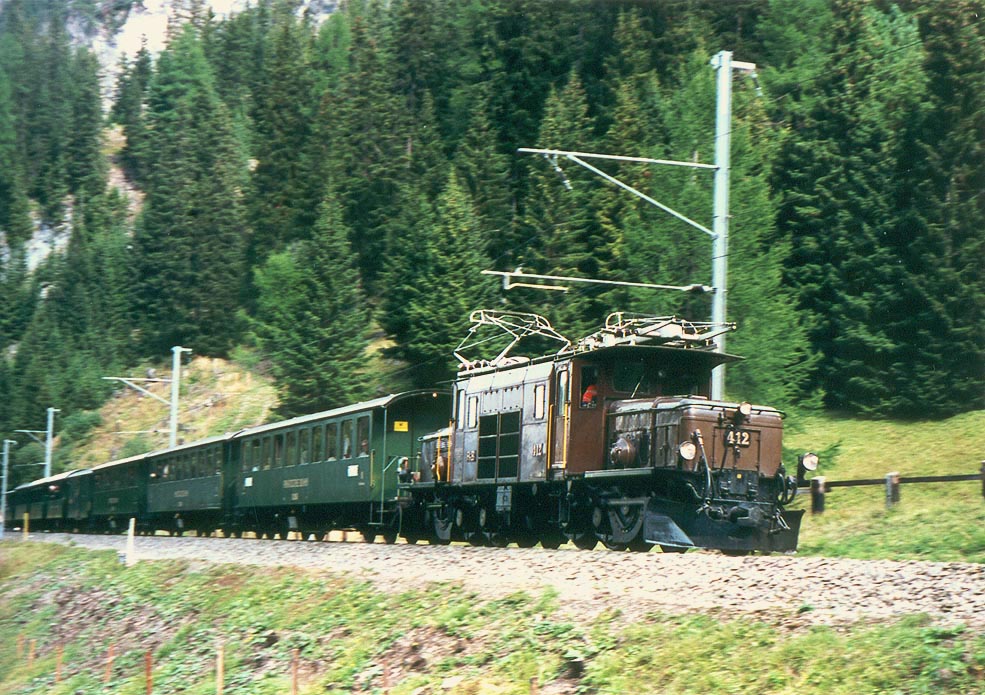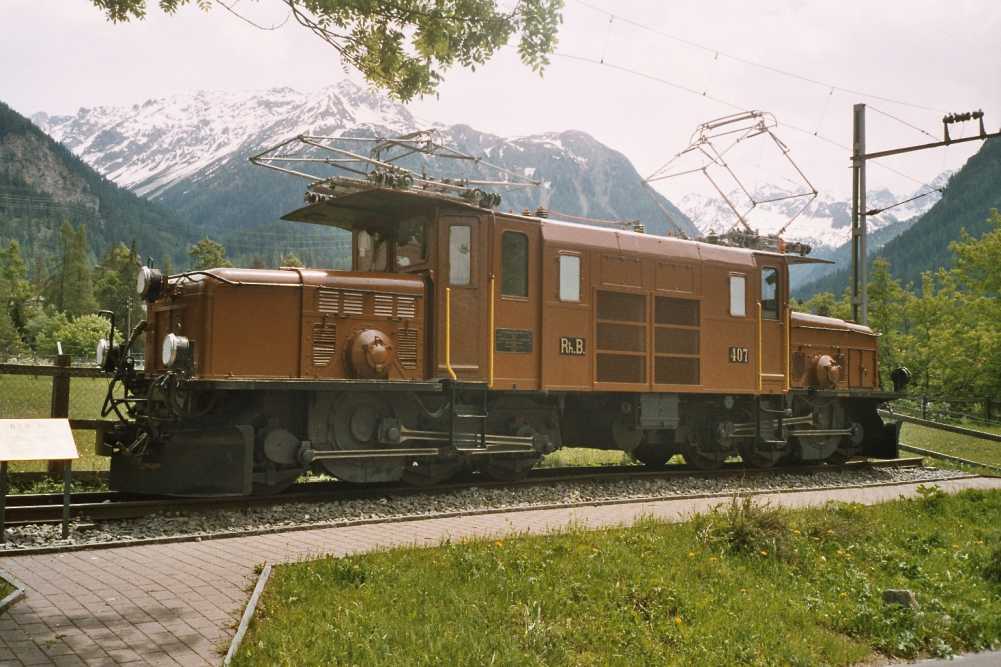|
Albula Railway Museum
The Albula Railway Museum (german: Bahnmuseum Albula) is located at the Bergün/Bravuogn (Rhaetian Railway station), Bergün/Bravuogn railway station of the Albula Railway of the Swiss Rhaetian Railway. The museum is in operation since 2012. The museum tells the history of the construction of the Albula Railway and shows many historical plans and artifacts. Topographic simulations and demonstrations of the tunneling methods are part of the multimedia displays. One section of the museum houses a miniature Albula Railway operating in O scale built by Bernhard Tarnutzer that includes buildings, viaducts, and tunnels from the 1950s and 1960s. The Rhaetian Railway Ge 6/6 I "Crocodile (locomotive), crocodile" #407 has been placed at its entrance and can be used by visitors for a ride simulation. References External links Home page (in German) {{authority control Bergün Filisur Museums in Graubünden Railway museums in Switzerland Rhaetian Railway ... [...More Info...] [...Related Items...] OR: [Wikipedia] [Google] [Baidu] |
Albula
Albula may refer to: Places *Albula, an old (possibly legendary) name of the Tiber river Switzerland *Albula Range, a mountain range *Albula (river), a tributary of the Hinterrhein *Albula District, a district in canton Graubünden until 2017 **Albula/Alvra, a municipality *Albula Pass *Albula Railway, part of the Rhaetian Railway *Albula Region, which replaced Albula District in 2017 *Albula Tunnel, located on the Albula Railway Zoology Moths *''Agrisius albula'', a moth of family Erebidae *''Dichomeris albula'', a moth of family Gelechiidae *''Machimia albula'', a moth of family Oecophoridae *''Meganola albula'', a moth of family Nolidae *''Metasia albula'', a moth of family Crambidae *''Nevadopalpa albula'', a moth of family Gelechiidae *''Nodozana albula'', a moth of family Erebidae *''Spodoptera albula'', a moth of family Noctuidae Other species *Albula (fish), ''Albula'' (fish), a genus of ray-finned fish *''Coregonus albula'', a whitefish of family Salmonidae *''Eurem ... [...More Info...] [...Related Items...] OR: [Wikipedia] [Google] [Baidu] |
Bergün/Bravuogn (Rhaetian Railway Station)
Bergün/Bravuogn (german: Bergün, rm, , in the local Romansh dialect ''Brauégn'') is a village and former municipality in the Albula Region in the canton of Graubünden in Switzerland. The double name (German/Romansh) has been the official name since 1943. On 1 January 2018 the former municipalities of Bergün/Bravuogn and Filisur merged into the new municipality of Bergün Filisur. History Bergün/Bravuogn is first mentioned in 1209 as ''de Bregonio''. Geography Bergün/Bravuogn has an area, , of . Of this area, 21.4% is used for agricultural purposes, while 20.4% is forested. Of the rest of the land, 0.8% is settled (buildings or roads) and the remainder (57.5%) is non-productive (rivers, glaciers or mountains). Before 2017, the municipality was located in the Bergün sub-district of the Albula district, after 2017 it was part of the Albula Region. It is located on the Albula river and along the Albula Pass road. Lai da Ravais-ch is within the village. It consist ... [...More Info...] [...Related Items...] OR: [Wikipedia] [Google] [Baidu] |
Albula Railway
The Albula Railway (german: Albulalinie; it, Linea dell'Albula; rm, Lingia da l'Alvra) is a single track metre gauge railway line forming part of the so-called core network of the Rhaetian Railway (RhB), in the canton of Graubünden, Switzerland. It links Thusis on the Hinterrhein at and Filisur at with the spa resort of St. Moritz in Engadine at . Construction of the Albula Railway was begun in September 1898, the opening took place on 1 July 1903, and the extension to St. Moritz commenced operations on 10 July 1904. With its 55 bridges and 39 tunnels, the line is one of the most spectacular narrow gauge railways in the world. On 7 July 2008, the Albula Railway and the Bernina Railway, which also forms part of the RhB, were jointly recorded in the list of UNESCO World Heritage Sites, under the name ''Rhaetian Railway in the Albula / Bernina Landscapes''. The best known trains operating on the Albula Railway are the Glacier Express and the Bernina Express. History ... [...More Info...] [...Related Items...] OR: [Wikipedia] [Google] [Baidu] |
Rhaetian Railway
The Rhaetian Railway (german: Rhätische Bahn; it, Ferrovia retica; rm, Viafier retica), abbreviated RhB, is a Swiss transport company that owns the largest network of all private railway operators in Switzerland. Headquartered in Chur, the RhB operates all the railway lines of the Swiss canton of Grisons, except for the line from Sargans to the cantonal capital, Chur, which are operated by Swiss Federal Railways (SBB CFF FFS), as well as the line from Disentis/Mustér to the Oberalp Pass and further on to Andermatt, Uri, which is operated by Matterhorn Gotthard Bahn (MGB). Inaugurated in 1888 and expanded from 1896 onwards in various sections, the RhB network is located almost entirely within Grisons, with one station across the Italian border at Tirano. The Rhaetian Railway serves a number of major tourist destinations, such as St. Moritz and Davos. One of the RhB lines, the Bernina Railway, crosses the Bernina Pass at above sea level and runs down to ... [...More Info...] [...Related Items...] OR: [Wikipedia] [Google] [Baidu] |
O Scale
O scale (or O gauge) is a scale commonly used for toy trains and rail transport modelling. Introduced by German toy manufacturer Märklin around 1900, by the 1930s three-rail alternating current O gauge was the most common model railroad scale in the United States and remained so until the early 1960s. In Europe, its popularity declined before World War II due to the introduction of smaller scales. O gauge had its heyday when model railroads were considered toys, with more emphasis placed on cost, durability, and the ability to be easily handled and operated by pre-adult hands. Detail and realism were secondary concerns, at best. It still remains a popular choice for those hobbyists who enjoy running trains more than they enjoy other aspects of modeling, but developments in recent years have addressed the concerns of scale model railroaders making O scale popular among fine-scale modellers who value the detail that can be achieved. The size of O is larger than OO/HO layouts, ... [...More Info...] [...Related Items...] OR: [Wikipedia] [Google] [Baidu] |
Rhaetian Railway Ge 6/6 I
The Rhaetian Railway Ge 6/6 I is a class of metre gauge C′C′ electric locomotives operated by the Rhaetian Railway (RhB), which is the main railway network in the Canton of Graubünden, Switzerland. The class is so named because it was the first class of locomotives of the Swiss locomotive and railcar classification type ''Ge 6/6'' to be acquired by the Rhaetian Railway. According to that classification system, Ge 6/6 denotes a narrow gauge electric adhesion locomotive with a total of six axles, all of which are drive axles. Due to their shape – they are similar in form to the SBB-CFF-FFS Crocodiles of the Gotthard Railway – the Ge 6/6 I locomotives have also collectively been nicknamed the ''Rhaetian'' '' Crocodiles'' by rail fans. Their internal working RhB designation is ''C-C''. As with its standard-gauge counterpart, the Ge 6/6 is articulated, with a gear-driven Jackshaft between the two end axles of each unit, ... [...More Info...] [...Related Items...] OR: [Wikipedia] [Google] [Baidu] |
Crocodile (locomotive)
Crocodile (German ''Krokodil'') electric locomotives are so called because they have long "noses" at each end, reminiscent of the snout of a crocodile (see also Steeplecab). These contain the motors and drive axles, and are connected by an articulated center section. The center section usually contains the crew compartments, pantographs and transformer. The name was first applied to Swiss locomotives. Sometimes the term is applied to locomotives in other countries of a similar design. History Switzerland Class Ce 6/8 A prototype locomotive, SBB-CFF-FFS Ce 6/8 I number 14201, was ordered in June 1917. The production "Crocodiles" were the series ''SBB Ce 6/8 II'' and ''SBB Ce 6/8 III'' locomotives of the SBB, Swiss Federal Railways, built between 1919 and 1927. There were 33 class Ce 6/8 II and 18 class Ce 6/8 III, making a total (excluding the prototype) of 51 locomotives. These locomotives were developed for pulling heavy goods trains on the steep tracks of the Gotthar ... [...More Info...] [...Related Items...] OR: [Wikipedia] [Google] [Baidu] |
Bergün Filisur
Bergün Filisur is a municipality in the Albula Region in the canton of Graubünden in Switzerland. On 1 January 2018 the former municipalities of Bergün/Bravuogn and Filisur merged to form the new municipality of Bergün Filisur. History Bergün Bergün/Bravuogn is first mentioned in 1209 as ''de Bregonio''. Filisur Filisur is first mentioned in 1262 as ''villa Fallisour''. Geography After the merger, Bergün Filisur has an area, , of . Population The new municipality has a population () of . Historic Population The historical population is given in the following chart. During construction of the Rhaetian Railway line the population of both communities increased significantly. Colors= id:lightgrey value:gray(0.9) id:darkgrey value:gray(0.8) ImageSize = width:1100 height:500 PlotArea = height:350 left:100 bottom:90 right:100 Legend = columns:3 left:220 top:70 columnwidth:160 AlignBars = justify DateFormat = x.y Period = from:0 till:2200 TimeAxis = ... [...More Info...] [...Related Items...] OR: [Wikipedia] [Google] [Baidu] |
Museums In Graubünden
A museum ( ; plural museums or, rarely, musea) is a building or institution that cares for and displays a collection of artifacts and other objects of artistic, cultural, historical, or scientific importance. Many public museums make these items available for public viewing through exhibits that may be permanent or temporary. The largest museums are located in major cities throughout the world, while thousands of local museums exist in smaller cities, towns, and rural areas. Museums have varying aims, ranging from the conservation and documentation of their collection, serving researchers and specialists, to catering to the general public. The goal of serving researchers is not only scientific, but intended to serve the general public. There are many types of museums, including art museums, natural history museums, science museums, war museums, and children's museums. According to the International Council of Museums (ICOM), there are more than 55,000 museums in 202 countrie ... [...More Info...] [...Related Items...] OR: [Wikipedia] [Google] [Baidu] |
Railway Museums In Switzerland
Rail transport (also known as train transport) is a means of transport that transfers passengers and goods on wheeled vehicles running on rails, which are incorporated in tracks. In contrast to road transport, where the vehicles run on a prepared flat surface, rail vehicles ( rolling stock) are directionally guided by the tracks on which they run. Tracks usually consist of steel rails, installed on sleepers (ties) set in ballast, on which the rolling stock, usually fitted with metal wheels, moves. Other variations are also possible, such as "slab track", in which the rails are fastened to a concrete foundation resting on a prepared subsurface. Rolling stock in a rail transport system generally encounters lower frictional resistance than rubber-tyred road vehicles, so passenger and freight cars (carriages and wagons) can be coupled into longer trains. The operation is carried out by a railway company, providing transport between train stations or freight customer ... [...More Info...] [...Related Items...] OR: [Wikipedia] [Google] [Baidu] |




